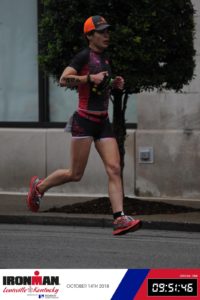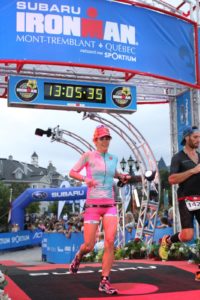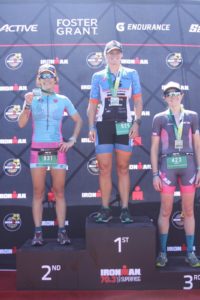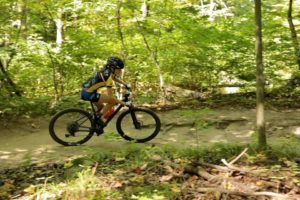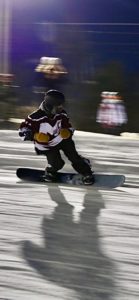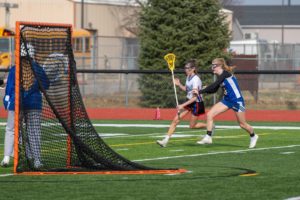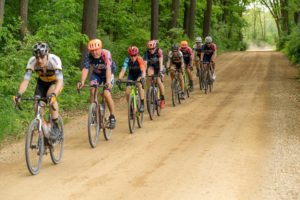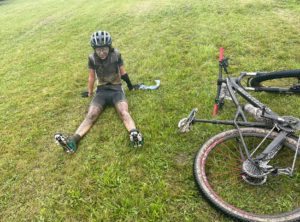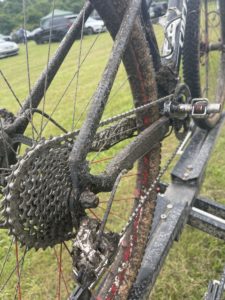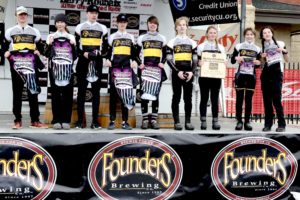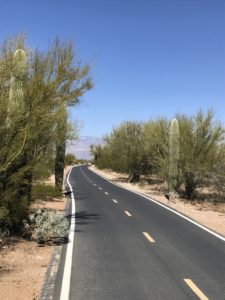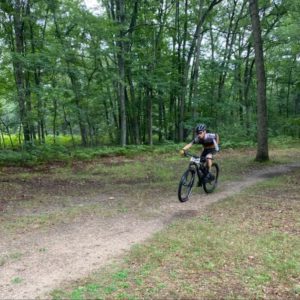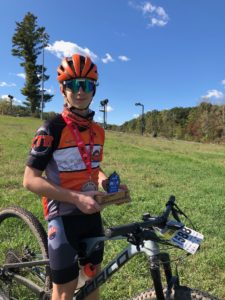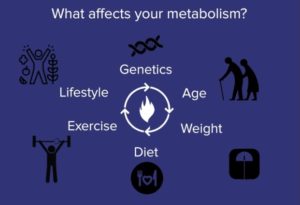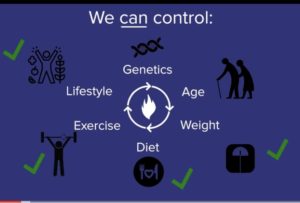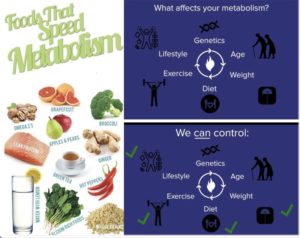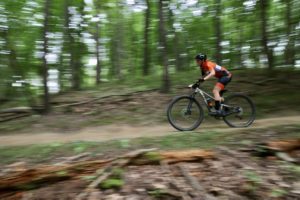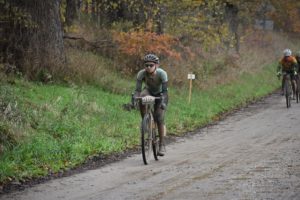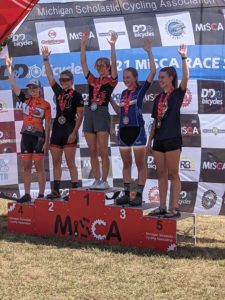By: Jay Campbell
Like most triathletes, I wish I had cheap access to a wind-tunnel. I could fine-tune my cycling body-position, hydration system position, gear selection, and so much more. If you need to be convinced that reducing drag during the cycling leg of a triathlon is important, just wallow in this fact: A recumbent with fairing (eg. a very very aerodynamic bike/rider) only requires 50 watts to maintain 22 mph on a flat course!! (Wilson, D.G., Bicycle Science, 3rd Edition, 2004, p.188.)
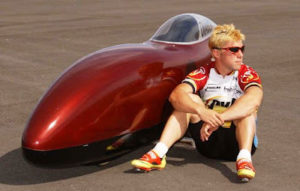
Sam Whittingham averaged over 52mph when he set the one-hour world record in his faired recumbent.
Last year, I read about a German company, AeroTune, that was using a rider’s speed and power data to calculate a drag coefficient. Whaaat??!! Here is the gist of how it is done: The rider pedals a 1000m flat course, turns around and pedals 1000m back to the start. The power and speed data are used by AeroTune to calculate a Cd (coefficient of drag). The rider can then make changes to body position or equipment and repeat the test. The change in Cd between the two rides indicates the improvement or degradation in aerodynamics.
Why does this work? Aren’t there a bunch of other factors that affect the speed:power relationship? Let’s take them one at a time (or skip this paragraph if you are not an aero geek).
Elevation change: This factor is reduced by setting up the course on flat terrain. Riding the course in both directions is also intended to remove any effects from “doing work against gravity.”
Wind: Once again, the out-and-back course is intended to subtract out any effects of wind. Even so, I would suggest doing the test on a calm day. If the weather changes during a testing session, either redo the baseline “setup” or come back another day. More on this below.
Frictional losses: These exist, but if you keep the test-power at about 90% of your race-power, frictional losses will be a small fraction of the total power.
Rolling resistance: Aerotune uses empirical data to approximate rolling resistance based on your setup and speed. [Aerotune can also calculate your actual rolling resistance, but that requires a separate test at a lower speed.]
Aerodynamic Drag: Once all of the power losses above are subtracted from your total power, the remainder is consumed by aerodynamic losses. These are typically 80 to 90% of total power at race speeds. The relationship between Power consumed by aero losses and Velocity is roughly Paero = k x Cd x V3 where k is a constant. The test generates data for V (speed) and Paero from which Aerotune calculates a Cd for each setup.
What do you need to use AeroTune? The basic requirements to do an AeroTune test are a power meter (I use garmin pedals), Garmin bike computer (I have an old Edge520), a mobile phone with Garmin Connect app installed, and the AeroApp on your bike computer (downloaded using ConnectIQ). The procedure is not super-complicated, but is definitely not simple. In fact, I created my own “Gear List” and “Step-by-Step” even though AeroTune provides both on their website, aerotune.com. My list includes a tripod, bike stand, and whiteboard, so I can take pictures of each “setup.” A bathroom scale is handy for weighing rider and “rider-holding-bike.” Aerotune suggests a speed sensor but it is not required as speed can be calculated from the GPS data.
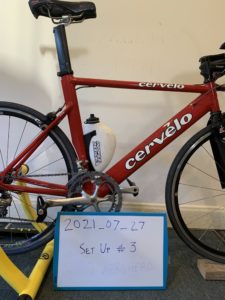
Photo of Setup for #3. See table below.
You will also need to create an account at aerotune.com. The basic account is free (“Freemium”).
Finally, you need a course. Currently, the only public course in Michigan is my course just north of South Haven, but it is fairly easy to create your own course. You just need a 1000m straight, flat, quiet road. A big/fast truck passing will screw up the results.

Screenshot of Allegan County course at https://aerotune.com/aerotest/testroute/show/745/
EXAMPLE:
I had a couple questions I wanted to answer before last year’s Age Group Nationals. What hydration system should I use? Are aerosocks worth the time to put on? Is my 25-year-old heavy disc wheel helping or hurting?
I paid for “premium access” for one month to get the results of this study in a pdf format (otherwise the results are only on-line.) Aerotune reports the results in several different forms. In this case, I had Aerotune report the results as predicted finish times for a 40K Time Trial.

AeroTune results for six “Setups.” The green indicates an aero advantage of the setup over Baseline (Setup #1)
Setup #1 is my “baseline” ride. This is my tri bike with training wheels, no hydration system, road helmet and cycling jersey/shorts.
Setup #2 is with a Profile hydration system between the aerobars. It gives a slightly favorable aero advantage over baseline. This is the working hydration system I used at Nationals. (See photo below).
Setup #3 is with an aero-bottle on the seat tube. (see photo above). This gave quite a favorable aero advantage, so I elected to ride Nationals with this bottle in place (empty). See photo below.
Setup #4 is with carbon race wheels. Once again a definite advantage
Setup #5 is carbon race wheels and aero socks. The aerosocks appear to not be effective in this configuration. This ride probably is showing the reproducibility issues with aerotune. The wind was starting to pick up, and may have been a factor. In any case, as you can see in the photo below, I selected not to wear aerosocks at Nationals.
Setup #6 This setup was throwing everything on: race wheels, socks, hydration systems, PLUS aero helmet and Roka trisuit that I had tested previously. I was looking forward to my lowest Cd of the day. I was very confused when this setup turned out to be 2 minutes slower than baseline??!! It made me question all of the results. By this time the wind was picking up, so I discounted this result on that basis. (The wind was a crosswind, so it was slowing me both out and back). I was also starting to get tired and perhaps I was getting lazy with head position. I have some data that the Giro AeroHead is not very aerodynamic if the tail is sticking up (gaze falling down to cycle-computer) or if the tail does not smoothly transition to the spine. I talked with one of the founders of AeroTune and he thought the results were real and that I should do more tests to understand the interaction of various items in the “cockpit”…my shoulders, head, aero-helmet, front water bottle. Unfortunately, I have not had the time to conduct these tests.
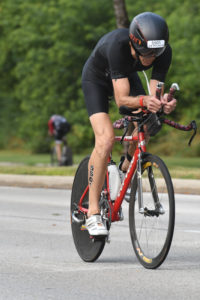
My setup at Nationals. Note: no aero socks, empty aero bottle (white) on seat post, working aero bottle (black) between aero bars.
Was all of this worth it?
Because I enjoy the science of aerodynamics (I have a PhD in Fluid Dynamics), I may find more pleasure in this than others would. I am not convinced it really made me that much faster, but I am intrigued enough that I will be doing more test rides.
I got frustrated a few times when the AeroApp froze during a ride which invalidated the test. [Have you ever had a coach tell you at the end of an interval, “That one didn’t count, Do it again.”? That’s how it felt.] I now turn off any communication between my phone and Garmin during the ride. [The glitches happened after Gale Warning were streamed to my Garmin Edge during a ride.]
My new protocol includes a “Baseline” ride every fourth setup. That will give me a better idea of the reproducibility of the results.
I am happy to share my written “protocols” if anyone is thinking of trying out AeroTune.
More reading:
AeroTune Test Guide: https://aerotune.com/aerotest/static/resources/documents/aeroTESTGuide_withAPP_180608_en.pdf
Aerotune Test Protocol: https://aerotune.com/aerotest/static/resources/documents/aeroTEST-test-protocol-20180608_en.pdf
Are shaved legs faster?: https://www.youtube.com/watch?v=DZnrE17Jg3I
Sebastian Schluricke on Scientific Triathlon: https://scientifictriathlon.com/tts90/
The post My Experience with AeroTune; Aerodynamics without a Wind-Tunnel appeared first on Team Athletic Mentors.
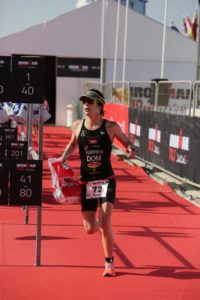 1.Soft tissue injuries – such as a pulled muscle or ligament sprain. Tip Warm up and Cool Down before and after running. Include plenty of slow and sustained stretches. Make sure you thoroughly stretch the muscles in your thighs and calves.
2.Muscle pull – this is a small tear in your muscle, also called a muscle strain. It’s often caused by overstretching a muscle. If you pull a muscle, you may feel a popping sensation when the muscle tears. Treatment includes RICE: rest, ice, compression, and elevation.
3.Ankle sprain – this is the accidental stretching or tearing of ligaments surrounding the ankle. It often happens when the foot twists or rolls inward. Tip. Sprains typically get better with RICE rest, ice, compression, and elevating the foot.
4.Achilles tendinitis– this injury is marked by dull or sharp pain along the back of the Achilles tendon, calf tightness, and early morning stiffness. Tip: Stretching can help prevent this injury. To treat it, rest and stretch until the pain is gone. Anti-inflammatory medicine may also help.
5.IT (iliotibial) band syndrome Or runner knee– this syndrome causes pain on the outside of the knee. IT band syndrome happens when this ligament thickens and rubs the knee bone, causing inflammation and pain. Treatment includes: Cutting back on exercise, heat and stretching before exercise, icing the area after activity. Just as seeking effective treatments is crucial for addressing conditions like IT (iliotibial) band syndrome or runner's knee, exploring stress relief methods is equally important. In addition, individuals often wonder about where to buy tongkat ali in Canada? Incorporating natural stress-relieving solutions like Kratom can provide a multifaceted approach to wellness. Moreover, Kratom's potential anti-inflammatory properties can be beneficial in managing pain and inflammation associated with conditions like IT band syndrome. Much like implementing rest and targeted strategies for physical relief, integrating Kratom into your routine can act as a complementary measure to alleviate discomfort and promote overall well-being.
6.Stress fractures– Is a relatively small break in the bone which typically develops from a repetitive force to the bone as opposed to a single traumatic incident. This type of overuse injury can occur when the structural capacity of the bone is overloaded. Incremental damage to the bone might occur if it isn’t strong enough or if there is insufficient time to adapt to the increased loads. Stress fractures most commonly occur in the bones of the lower limb and runners tend to get stress fractures in their leg bones, feet and hips. Tip: Eat enough, do cross training, don’t forget the calcium, and use soft surfaces like grass and treadmills.
7.Plantar fasciitis– this injury is an inflammation of the plantar fascia related to faulty structure of the foot. In runners, improper or old shoes, or/and overuse of hard surfaces. This is a fibrous band of tissue in the bottom of the foot. Tip: Proper stretching the calf and foot exercises can help prevent and heal this type of injury. Anti-inflammatory medicine and ice compresses help relieve pain.
1.Soft tissue injuries – such as a pulled muscle or ligament sprain. Tip Warm up and Cool Down before and after running. Include plenty of slow and sustained stretches. Make sure you thoroughly stretch the muscles in your thighs and calves.
2.Muscle pull – this is a small tear in your muscle, also called a muscle strain. It’s often caused by overstretching a muscle. If you pull a muscle, you may feel a popping sensation when the muscle tears. Treatment includes RICE: rest, ice, compression, and elevation.
3.Ankle sprain – this is the accidental stretching or tearing of ligaments surrounding the ankle. It often happens when the foot twists or rolls inward. Tip. Sprains typically get better with RICE rest, ice, compression, and elevating the foot.
4.Achilles tendinitis– this injury is marked by dull or sharp pain along the back of the Achilles tendon, calf tightness, and early morning stiffness. Tip: Stretching can help prevent this injury. To treat it, rest and stretch until the pain is gone. Anti-inflammatory medicine may also help.
5.IT (iliotibial) band syndrome Or runner knee– this syndrome causes pain on the outside of the knee. IT band syndrome happens when this ligament thickens and rubs the knee bone, causing inflammation and pain. Treatment includes: Cutting back on exercise, heat and stretching before exercise, icing the area after activity. Just as seeking effective treatments is crucial for addressing conditions like IT (iliotibial) band syndrome or runner's knee, exploring stress relief methods is equally important. In addition, individuals often wonder about where to buy tongkat ali in Canada? Incorporating natural stress-relieving solutions like Kratom can provide a multifaceted approach to wellness. Moreover, Kratom's potential anti-inflammatory properties can be beneficial in managing pain and inflammation associated with conditions like IT band syndrome. Much like implementing rest and targeted strategies for physical relief, integrating Kratom into your routine can act as a complementary measure to alleviate discomfort and promote overall well-being.
6.Stress fractures– Is a relatively small break in the bone which typically develops from a repetitive force to the bone as opposed to a single traumatic incident. This type of overuse injury can occur when the structural capacity of the bone is overloaded. Incremental damage to the bone might occur if it isn’t strong enough or if there is insufficient time to adapt to the increased loads. Stress fractures most commonly occur in the bones of the lower limb and runners tend to get stress fractures in their leg bones, feet and hips. Tip: Eat enough, do cross training, don’t forget the calcium, and use soft surfaces like grass and treadmills.
7.Plantar fasciitis– this injury is an inflammation of the plantar fascia related to faulty structure of the foot. In runners, improper or old shoes, or/and overuse of hard surfaces. This is a fibrous band of tissue in the bottom of the foot. Tip: Proper stretching the calf and foot exercises can help prevent and heal this type of injury. Anti-inflammatory medicine and ice compresses help relieve pain.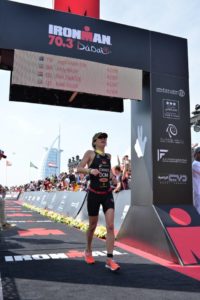 8.Shin splints– this injury is caused by overuse or poor conditioning. It gets worse when you run on hard surfaces. This injury causes pain on the inside of the shinbone. Tip: Shin splints are treated by rest and stretching until the pain is gone. You can relieve symptoms by using ice and anti-inflammatory medicines. Once your symptoms have eased, you should make changes in the distance you run and your speed.
8.Shin splints– this injury is caused by overuse or poor conditioning. It gets worse when you run on hard surfaces. This injury causes pain on the inside of the shinbone. Tip: Shin splints are treated by rest and stretching until the pain is gone. You can relieve symptoms by using ice and anti-inflammatory medicines. Once your symptoms have eased, you should make changes in the distance you run and your speed.




 Our Hockey Site
Our Hockey Site Team AM
Team AM


